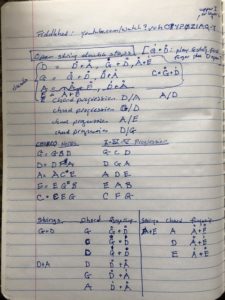When I was learning violin as a kid, I was given books of scales and page-long exercises called etudes like the one above.
Once in awhile I would fight my way through the whole thing. But my attention would drift to other things. It was hard to stay engaged; I almost gave it up. My mom told me she would stop paying for lessons if I didn’t practice at least a half an hour a day. That was enough incentive to keep me going for a little bit longer, and then I was fortunate to discover that making music could be fun.
It dawned on me that there were other ways to practice and make music. I found that each etude had some basic pattern that was then varied melodically for a whole page. It was much more fun and interesting for me to take this basic pattern, or maybe the first line and then play with it on my own.
- Transpose to another string
- Add rhythms
- Create new melodies by stretching out certain notes or re-arranging notes.
I was fiddling before I even knew I was fiddling.
In college I played viola in the university symphony. There was a graduate student assigned to tutor and help me learn the music. Using a pencil, he put brackets around a difficult bar and had me play it a few single times and then he had me play it continuously in a loop. He didn’t call it looping, but that’s what it was.
Loop practice taught me to look for hidden exercises and etudes within tunes and then practice them in many different ways until my fingers and hands knew what to do.
Recently I went to see a great fiddler named Bruce Molsky play at the Freight And Salvage in Berkeley, California. I went with two students named Dayved and Rob. We got there early, got good seats and joked around as the venue filled up.
While waiting for the show to start, a few people recognized me from FiddleHed and said hello, which was nice! A woman named Sarah said, “I already spent half the day with you online.” She told me she was learning chords on the fiddle and had taken some notes:

Hi, Jason–It was so eerie, having spent half the day with you yesterday online, to see you incarnate a few rows back at the Freight. Here are my notes on both your doublestop videos…
— Sarah
Sarah came up with her own personal way of notating fiddle chords. By going through this process of designing a little system, she developed a much better understanding of how different chords are connected to tunes and to each other.
This is a good example of something I tell my in-person students: Write your own fiddle book. Figure out what you need to work on most and document the things you practice. Make connections. Create exercises. Expand on them the next day.
Your fiddle book can be anything you want it to be. It can be a simple list of tunes you like. You can create a bucket list of tunes you want to learn. You can draw pictures on the page. Whatever it takes to love the process of learning and playing.
Use an online notebook, like the Practice Journals on FiddleHed. Or use an old-school spiral-bound or Moleskine notebook. Though I’m a big tech nerd, I still find a lot of utility and joy in using a paper notebook, which is excellent for brainstorming and sloppy idea capture. I go into more detail on all this in the lesson: How To Track Your Practice.
My whole approach to teaching is to not only give people exercises so they have something to practice, but to show them how exercises are made so they can make their own and then practice them in creative ways. I want students to make connections between exercises and tunes so that see why it’s good to practice scales and exercises. I go into this more in the ever-expanding course called How To Make Scales Fun.
It’s my hope that online students will practice these and then see how they can apply the exercise-making process to other things that I haven’t explicitly taught. I also really, really try to help students find joy in this approach.
It took me ten years before I even started to learn how to practice. Better late than never. And now I can help you and others to get there faster than I did. Just like Sarah, I wrote my own own fiddle book which became FiddleHed. Now it’s grown beyond me. You and all the students I’ve ever taught have helped to create this.
So thanks for all your insights and questions FiddleHed continues to evolve.
What have you discovered? What still gives you trouble? If you feel like sharing your answers with me, just fill in the workbook below.
Good, now go fiddle with it.

